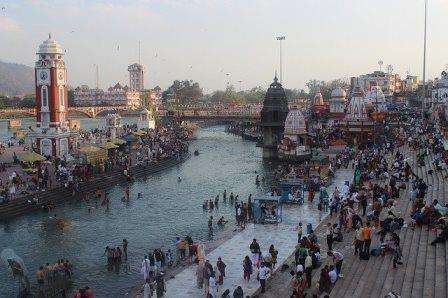Q- Describe the journey of river Ganga in India and which rivers join it in route.
Answer- The river Ganga originates in devprayag when two rivers Bhagirathi and Alaknanda meet together. Through this combination of Bhagirathi and Alaknanda, the river Ganga originates in devprayag. After flowing from devprayag it enters the plain in Haridwar, which is also a holy place for Hinduism followers. Most of the Himalayan rivers join Ganga as its tributaries.
Some of the popularly known tributaries of Ganga are: Ghaghra, Gandak, Yamuna, Gomti, the Kosi, Raganga, etc. The Yamuna is one of the biggest tributaries of the Ganga river, it is also a Himalayan river.
Important Questions for Class 9th
- Why were some people against Mandal commission recommendations
- Why does winter in India experience a dry season
- How is food requirement estimated in the poverty line?
In the above answer, we provided you answer to the question that asked about Describe the journey of river ganga in india and which rivers join it in route. So, we tell you about how the river Ganga is formed or originated in devprayag and also provide names of some most popular rivers that join it in route.
So, we hope that this answer might be very useful. If yes so do not forget to follow our blog for more interesting and helpful posts. The follow button is available at the bottom of this article. Before you leave this page we would like to provide you with answers to some mostly asked questions of class 9th examinations. If you are a student of class 9th so you should read them very carefully. These are given below:
Before finishing this article in the below paragraphs we would like to tell you a little about the river Ganga. It’s all for extra knowledge so if you like to read it so you can. We recommend you to read these lines because these paragraphs might be very helpful in improving your General knowledge.

River Ganga- Describe the journey of river Ganga in India and which rivers join it in route
We all know that Ganga is one of the largest rivers in India whose length is about 2500 Km. It is also a transboundary river in the Asian continent. The river Ganga flows mainly in Bangladesh and India. Ganga originates in devprayag when two rivers Bhagirathi and Alaknanda meet together. Through this combination of Bhagirathi and Alaknanda, the river Ganga originates in devprayag which is also a very popular tourist place.
After flowing from devprayag it enters the plain in Haridwar, which is also a holy place for Hinduism followers. Most of the Himalayan rivers join Ganga as its tributaries. Now we are going to talk a little about the origination of the Alaknanda and Bhagirathi river. So, the Bhagirathi river originates from a very popular glacier that is the Gangotri glacier at Gomukh, and the Alaknanda river formes through the melting of snow of Northern Himalayas. Some of the most commonly known tributaries, as well as sub tributaries of the river Ganga, are as follows:
- Ghaghra
- Gandak
- Yamuna
- Gomti
- the Kosi
- Raganga
The Ganga Basin
The basin which is formed due to the river Ganga and its tributaries is called the Ganga Basin. The Ganga basin ranges from the Himalayas towards the Transhimalayas in the north. After falling in the Northern plain, the river Ganga over towards the east-south direction towards the Gangetic plains in Northern India. Here, Ganga gets one of the biggest tributary of Ganga that is Yamuna. In Bangladesh, the river Ganga is called ‘The Padma‘. In Bangladesh, it is connected by a lower stream of the Brahmaputra river that is Jamuna. It is very difficult for geographical researchers to measure the approximate length of the river Ganga as it has several tributaries and sub-tributaries.
The Ganga basin and Sunderban delta also create problems for geographical researchers to measure the length of river Ganga. The maximum peak discharge of the Ganges, as recorded at Hardinge Bridge in Bangladesh, exceeded 70000-meter cube per second (2,500,000 cubic ft/s). The minimum recorded at the same place was about 180-meter cube per second (6400 cubic ft/s) which was recorded in the year 1997.
